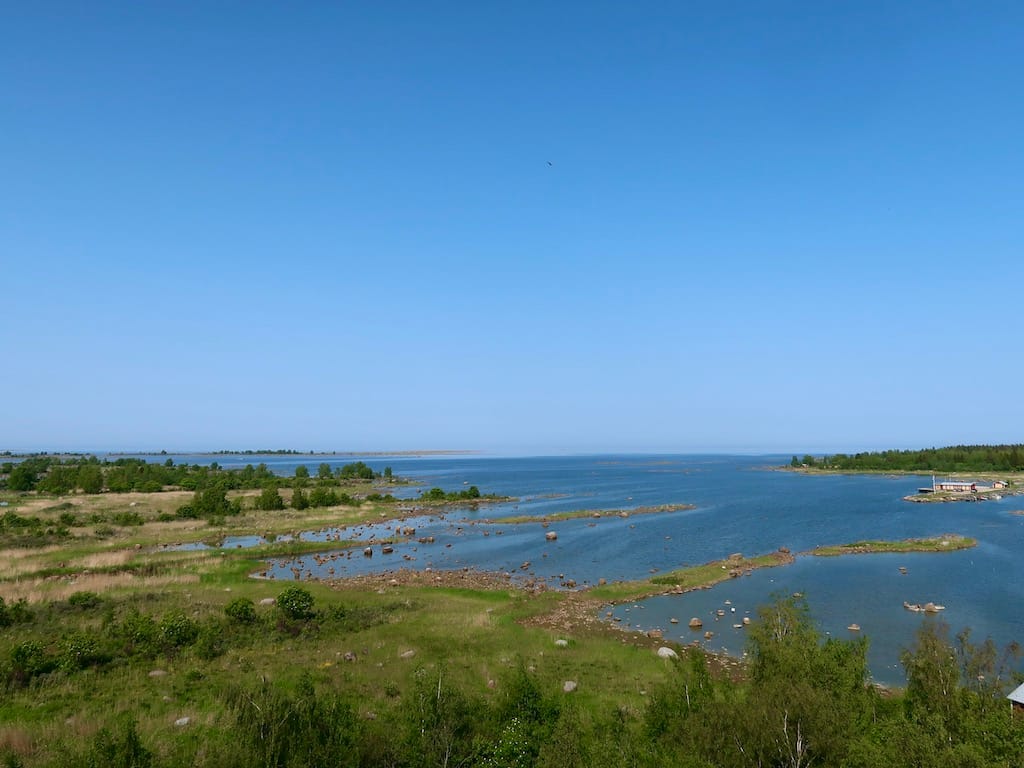Kvarken Archipelago.
Finland
We left Denmark with Kronborg Castle on the port side. After overnight stops at friends' old farm in Markaryd and at a campsite in Stockholm, we reached the Viking Line ferry M/S Gabriella to Helsinki. The cabin's panoramic windows offered a view of an evening trip out of the Swedish and a morning trip into the Finnish archipelago.
We sailed surrounded by large and small boats between cliffs with wooden houses. At night, we called on the Åland Islands in the Gulf of Bothnia, they are Finnish but Swedish-speaking and have internal self-government. We left the ferry in Helsinki after an exquisite breakfast.
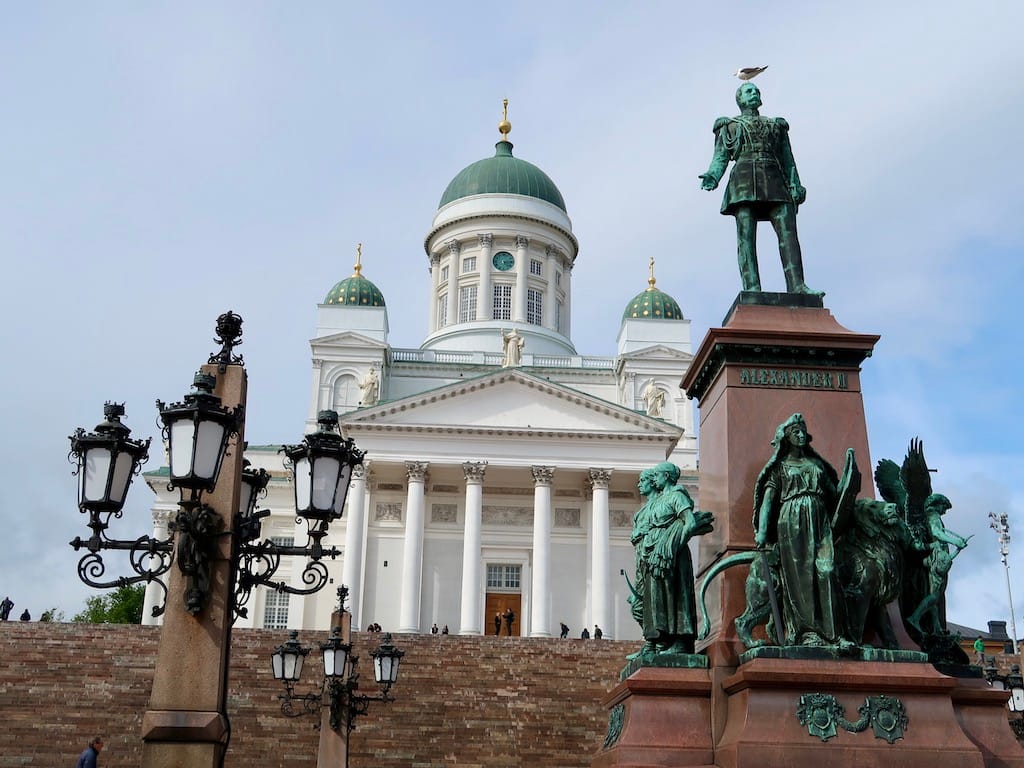
Architecture and design in Helsinki
In Finnish, the capital is called Helsinki, in the country's other official language, Swedish, it is called Helsingfors. We hint that Finland is bilingual, but you probably have to be a native to understand the identity-nuances in the use of languages. In the subway from the campsite to the centre, Finnish, Swedish and English were heard on the loudspeakers. Some signs in streets and parks are in Russian. We were impressed by the green, orderly, cosmopolitan city characterized by good architecture, good design and blue views towards the archipelago.
We arrived together with spring, and although we preferred long sleeves, many locals dressed in summer clothes. Most sights are within walking distance of the centre and it is easy to find cafes with good coffee and outdoor serving.
In the central area around Aleksanterinkatu and the Esplanadi, shops with Finnish design lie close. We noticed Marimekko's flowered textiles, Arabia's stylish porcelain and Artek's furniture of moulded plywood. The Stockmann department store is an indoor shopping mecca, while Kauppatori by the harbour offers souvenirs, fruit, vegetables and fast food from outdoor stalls.
We also got an impression of the city's architecture in different neighbourhoods and periods. In the neoclassical parliament building from 1931, we spoke with Frida Sigfrids about her life as an assistant to a politician and an active member of the Swedish People's Party. The Parliament is surrounded by iconic modern cultural buildings. Frida took us out to eat Italian in the church-like Central Station with a touch of Art Nouveau. Alvar Aalto's congress and concert building Finlandia House was hidden by tarpaulins because the white marble of the facade had to be replaced. See Frida's life story here.
The Sveaborg fortress was built by the Swedes from the middle of the 1700s as defence against the Russians. The plans were only partially realized, and when the Russians attacked in 1808, the commander quickly gave up fighting. The complex was developed as a naval base under Russian administration, but lost military importance and fell into disrepair. In 1918, it was taken over by the new Finnish government under the name Suomenlinna. The area served as a prison during the Finnish Civil War and until the 1960s as a military base. Now it is a picturesque destination for both locals and visitors, which can be reached by boat through the archipelago. We spent a day exploring the place, visiting the historically informative Suomenlinna Museum, a small toy museum with a large collection and a well-preserved WWII submarine.
The Senate Square with the statue of Tsar Alexander II of Russia and monumental buildings by the architect Carl Ludvig Engel was created when the capital moved from Turku to Helsinki in 1812. This was after Finland had become a Russian Grand Duchy in 1808. We visited the neoclassical Lutheran cathedral, Storkyrkan, which stands shining white above the Square. The nearby orthodox Uspenski cathedral in red stone with golden onion domes was closed, so we saw it from the outside.
Finland is predominantly Protestant with a Lutheran Church of which the majority are members. The smaller Orthodox Church belongs to the Patriarchate of Istanbul. These churches are recognized national churches, and receive a share of the members' tax payment, but there are also other denominations. When we asked Finns about their attitude to religion, we got the impression that many, like the Danes, mainly use the church for baptisms, confirmations, weddings, funerals and Christmas.
We regularly lingered in beautiful churches and prayer rooms filled with calming peace or sounding organ music. In Helsinki, in addition to Storkyrkan, we visited The Temppeliaukio church, which is hewn into the raw rock, and Kampin Kapelli, which offers silence in a cylindrical wooden house. Both buildings are examples of exquisite contemporary Finnish architecture.
Helsinki's monuments tell of culture and history, we noticed the classic statues of the first president Carl Gustaf Mannerheim and of the national poet Johan Ludvig Runeberg as well as the modern monuments to the national composer Jean Sibelius and to the Winter War.
Museum visits added new nuances to our understanding. The National Museum focused on Finnish identity. The nation emerged from violent wars and celebrated its centenary in 2017. In the fall of 2023, the exhibition was closed to undergo an extensive transformation. The Design Museum gave the impression of functional design with a focus on the past, present and future. The Ateneum Art Museum was reopened with a permanent exhibition under the headings: The Age of Nature, Images of a People, Modern Life and Art and Power. The exhibition "Generation 2023", in Amos Rex showed the works of young artists’ conveying emotions, identity and nature. The museum is partly underground, and the domed roof invited people to rest and play in the spring sun.
Knowledgeable guides in the inviting home and studio of Alvar Aalto and his two wives gave an impression of their life and work in creative interaction with the period's international modernism. Hanne was impressed by drawers and cupboards that opened onto the kitchen as well as the living room, Lars by workplaces that were both part of and separate from the home. The visit was a good preparation for visiting Aalto buildings on our further journey.
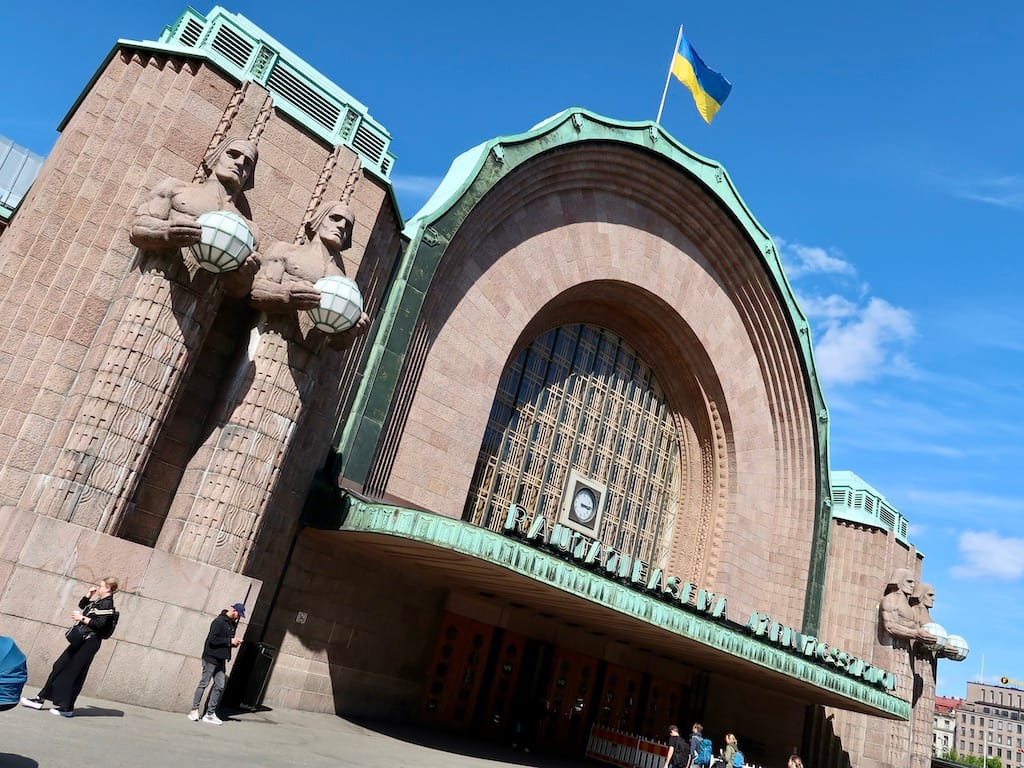
Turku Castle and Cathedral
Turku or Åbo in Swedish is Finland's oldest city, which was the country's capital until 1812 and European Capital of Culture in 2011.
Turku Castle has been built in stages since the end of the 13th century, the development is shown in fine models. It has served as a fortification, luxurious palace, administrative centre, prison, garrison and granary. The visit is a time journey through the Middle Ages and the Renaissance towards the present, guided by friendly hosts in authentic costumes. The restoration and conversion into a museum began in 1881.
We walked to the centre along Aurajoki or Aura Å, which has given the city its name. Along the way, we saw moored restaurant and museum ships. Turku Cathedral, like the castle, dates from the late Middle Ages. The building has been repeatedly damaged by war and fire. It is the headquarters of the Evangelical Lutheran Church of Finland. Its museum contains a chalice and a dish for communion, which the Dane Otto Rud took to Ejby Church on the island Zealand in 1509. The objects were returned in 1925.
The first Åbo Akademi moved to Helsinki after the fire in 1827, and Turku got a new Swedish university in 1918. The academy is housed in beautiful buildings near the cathedral. The Finnish University of Turku was founded 1920.
Abo Vestus Ars Nova is, as the name suggests, both an archaeological museum and an art museum. It is built on top of excavations of the medieval city, which are conveyed on the lower floor, the upper floor presents contemporary art.
The Luostarinmäki in Swedish Klosterbacken is an open air and crafts museum. It is set in a neighbourhood from the late 18th and early 19th century with wooden houses that survived the fire in 1827. The museum provides an insight into past environments and ways of life. Guides in period clothing tell about the residents, their lives and crafts. We talked with a violin maker and a young woman, who presented old games.
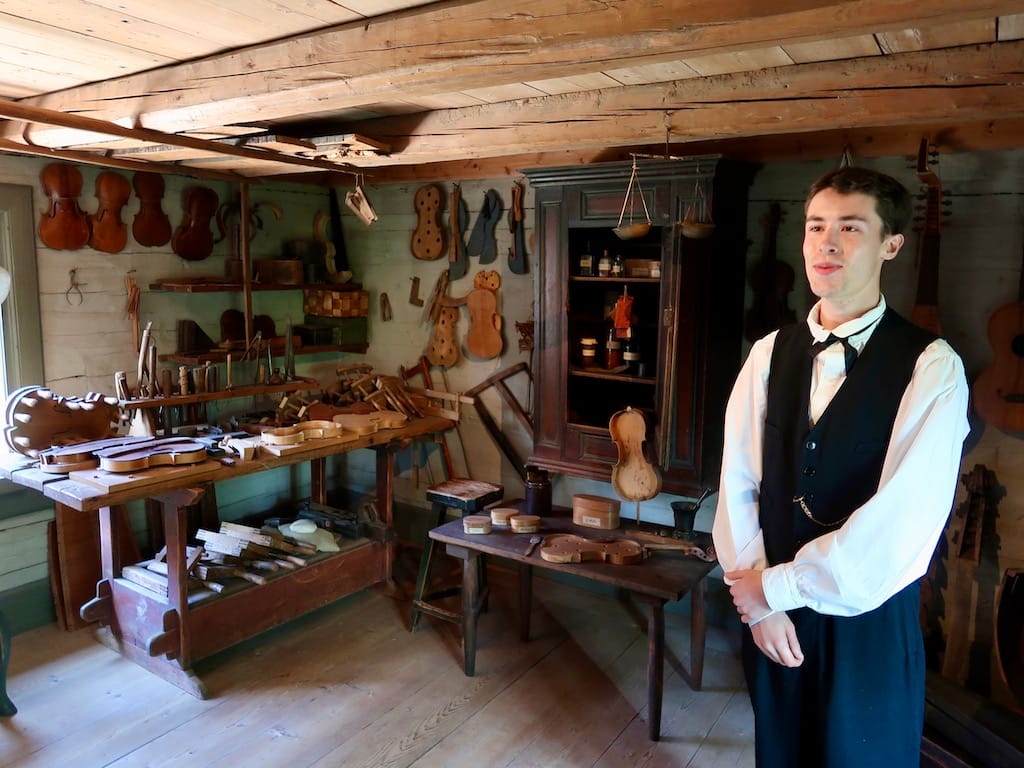
Sammallahdenmäki burial site
Sammallahdenmäki is a group of Bronze and Iron Age graves in rock heaps east of the town Rauma. The tombs, which are over 3500 years old, were built close to the coast, which land uplift has since moved west. They are associated with the introduction of sun worship and agriculture on family-owned land. Several archaeological investigations have been carried out on the site, in 2002 cremated human bones were found in six graves.
We took a walk from the north along the magical memorial site, which is located high in a pine forest on rocky ground. The graves appear as flat stone collections of different shapes and sizes. Here we learnt that you have to be careful not to lose your orientation in the magnificent Finnish nature.
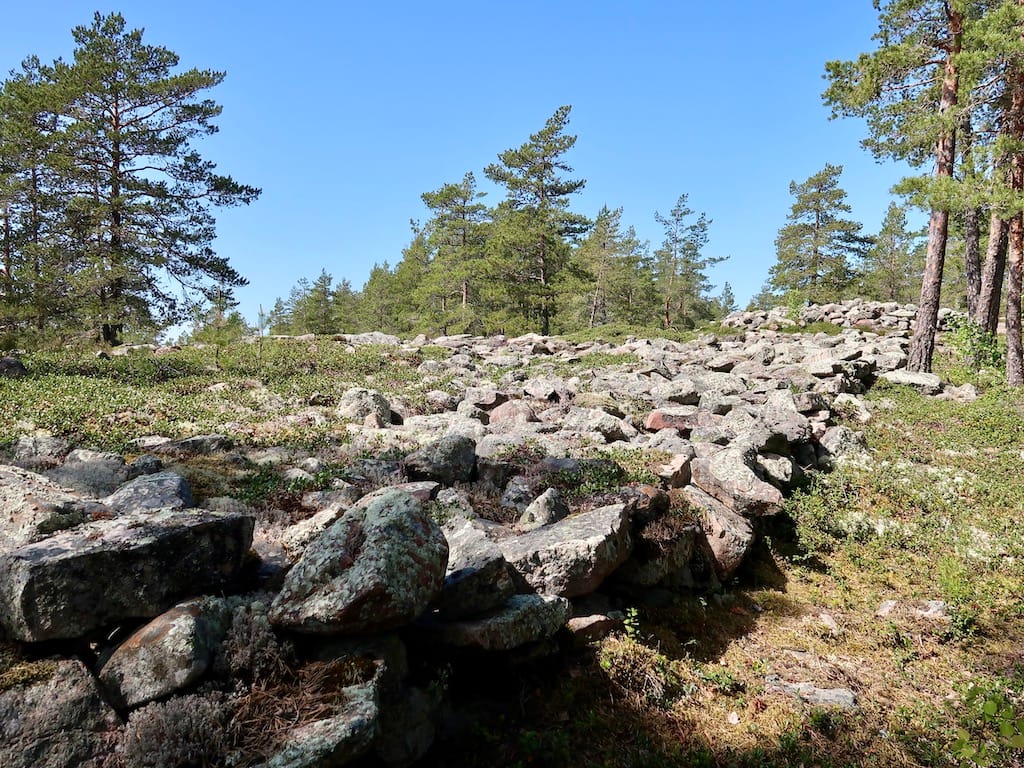
Wooden houses and shipping in Rauma
Rauma in Swedish Raumo is Finland's third oldest market town from 1442. The town is particularly known for its wooden houses and lace. It arose around a Franciscan monastery; whose church is one of the few brick buildings in the old town. Well-maintained wooden houses in many colors dominate, and they still function as homes, businesses, etc.
A friendly woman showed us around Tammela, presenting local building traditions and advising on maintenance. Marela Museum houses the story of a ship owner family's rise during Rauma's sailing boom in the 1890s and the family's decline and bankruptcy in the early 20th century. You are a guest in their stately living rooms and in the office with pictures of ships.
The Rauma Maritime Museum tells about a city in close contact with the world via shipping. The local dialect, which is kept alive by a group of elderly men, is characterized by loanwords brought home from other countries. The museum is housed in a former maritime school with a tower where sailors learned to navigate by the stars. Guided by an expert we tried entering Rauma Harbour in a ship simulator. This gave respect for how foresight you have to be as a helmsman. Visits to the port showed that it is still an important hub for shipping traffic.
We also saw Kituränn, which is said to be Finland's narrowest street. A man on the spot told that the street is the subject of jokes like: "A very fat woman could not punish her naughty child, because the child ran away through Kituränn!"
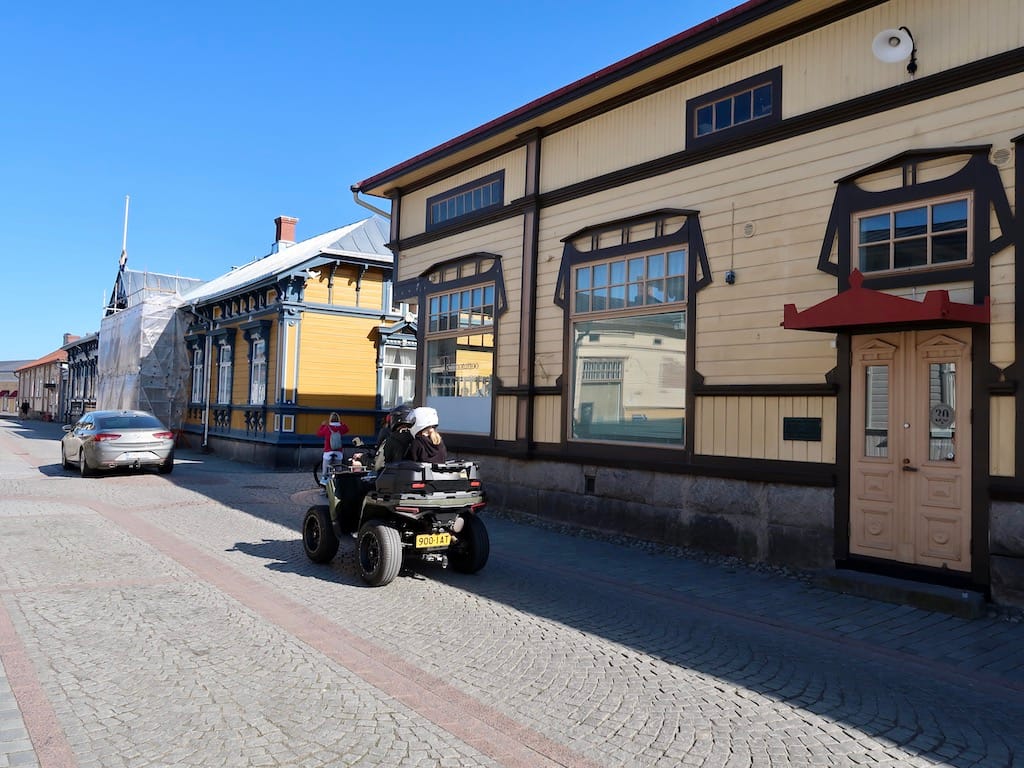
Olkiluoto nuclear power plant
North of Rauma lies Olkiluoto, which is one of Finland's two nuclear power plants. It has been producing electricity commercially since 1979. The plant's third reactor was fully operational in 2023 after a construction period of 18 years with several delays. It contributed to making Finland self-sufficient in electricity production 2023.
We visited the informative Visitor Centre, which visualizes the uranium's path from the mine, through processing to the nuclear reactor, as well as the radioactive waste's path to temporary and permanent storage. Albert Einstein as a wax figure welcomes with messy hair and beard.
The world's first permanent repository for radioactive waste, Onkalo, is built in the bedrock near the plant. According to Danish Michael Madsen's documentary "Into Eternity", the nuclear waste must be stored safely for 100,000 years after the repository is sealed. We were convinced that the Finns are careful. Nevertheless, we are pleased, that Danish politicians decided in 1985 that there should be no nuclear power on Danish soil. If current political considerations to change that decision gain support, we will again wear our old "Nuclear power? – No thanks” badges with the smiling sun!
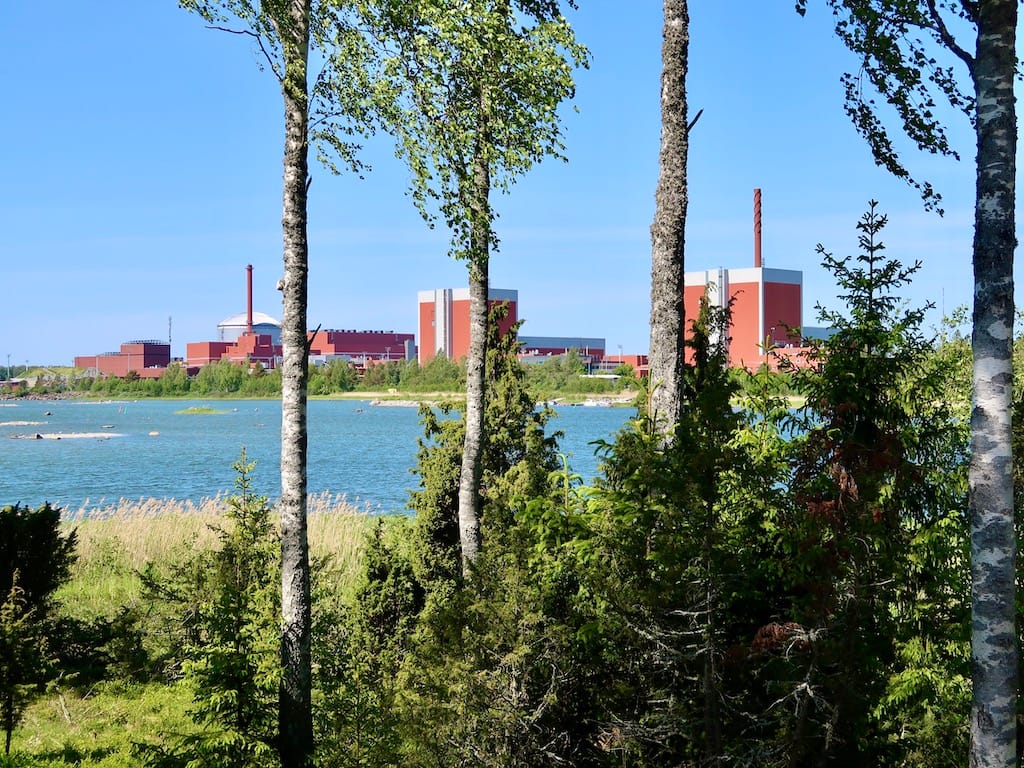
Stundars, Söderfjärden and Vaasa
Vaasa in Swedish Vasa is the capital of the Ostrobothnia region. It has roots in the 14th century, in 1852 it burned down and was recreated closer to the sea with a fire-resistant town plan. For a short period during the civil war in 1918 Vaasa was the capital of Finland. It is now known for the production of energy solutions, and we saw long trucks with wind turbine blades.
Stundars south of the city is a Finnish-Swedish open air museum with around 70 wooden buildings that have been moved there. The area has a local plan that stipulates that the surrounding houses must also be in old style. The museum had not yet fully opened for the season when we visited, but we were given a knowing tour and introduction to Finnish-Swedish history and building customs.
We also saw the nearby Söderfjärden. The landscape is shaped by a meteorite that created a sea bay, which was drained in the 1920s. Now the impressive circular crater is an agricultural and nature area with an information centre and bird towers. It is used as a resting place by migrating cranes.
The Ostrobothnian Museum conveys nature, culture and art. In the cellar the Kvarken Archipelago in Finnish Merenkurkun is described, on the ground floor Vaasa's development from farming town to industrial city, upstairs there is a permanent and changing art exhibitions. When we visited the museum, the exhibition "Kontakti" showed works about connections between outer physical and inner mental landscapes.
We met Olav Jern on the farm where his family has lived and worked since 1606. He told us about his life as a farmer, politically active person and County Chief Executive with administrative responsibility for regional development and spatial planning in Ostrobothnia. See Olav's life story here.
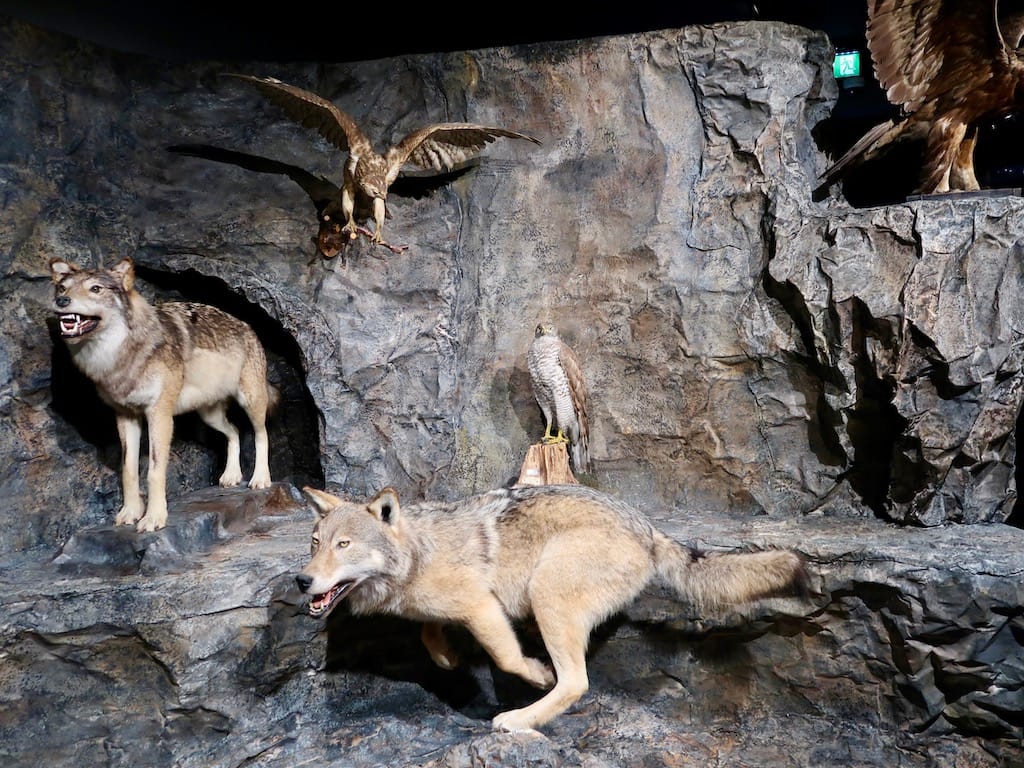
Hike in the Kvarken Archipelago
One of Olav's tasks as landscape director was the inclusion of the Kvarken Archipelago on UNESCO's list of Natural World Heritage in 2006, the High Coast in Västernorrland's län on the Swedish side had been included in 2000.
During the Ice Age, up to three kilometres of ice covered the landscape and depressed it almost a kilometre. It started to rise and move the coastline further out when the ice melted 10,500 years ago, this still continues at about eight millimetres a year. The perspective is that Finland may become connected to Sweden across the Gulf of Bothnia within the next 2000 years, but the process is delayed by rising water due to climate change.
We drove over Finland's longest bridge to the island of Replot and hiked around Bodvattnet, which several locals had recommended. It gave an insight into the characteristic landscape. Along the beautiful route there were signs with good descriptions of natural and cultural phenomena as well as a lookout tower with an overview.
An imaginative explanation for the difference between Sweden's high and Finland's low coast is that a giant boy waded from Sweden to Finland with stones from the Swedish side and threw them at the Finnish side.
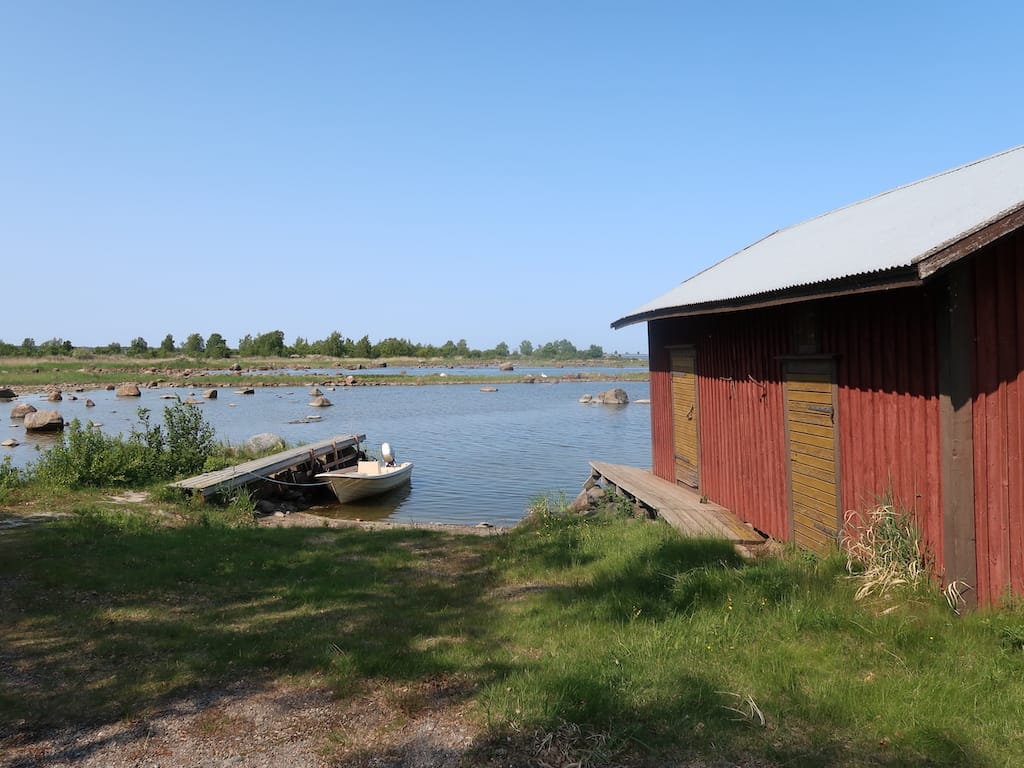
Martin and Ellen in Värlax
On the island of Värlax we visited Olav's brother Martin and his wife Ellen, who had helped us plan the trip in Finland and now answered our new questions about the country. They have a cabin in the wood with a beautiful view of the archipelago.
The menu was smoked wild salmon and a dessert of baked, traditional Finnish cheese with mulberry jam. Before dessert, Martin lit up their wood fired sauna and invited us to a good sweat and a cooling bath in the sea. After coffee from mugs with Mumi pictures, we went to bed with light bodies and minds at a clearing in the forest, where our Bulli was parked.
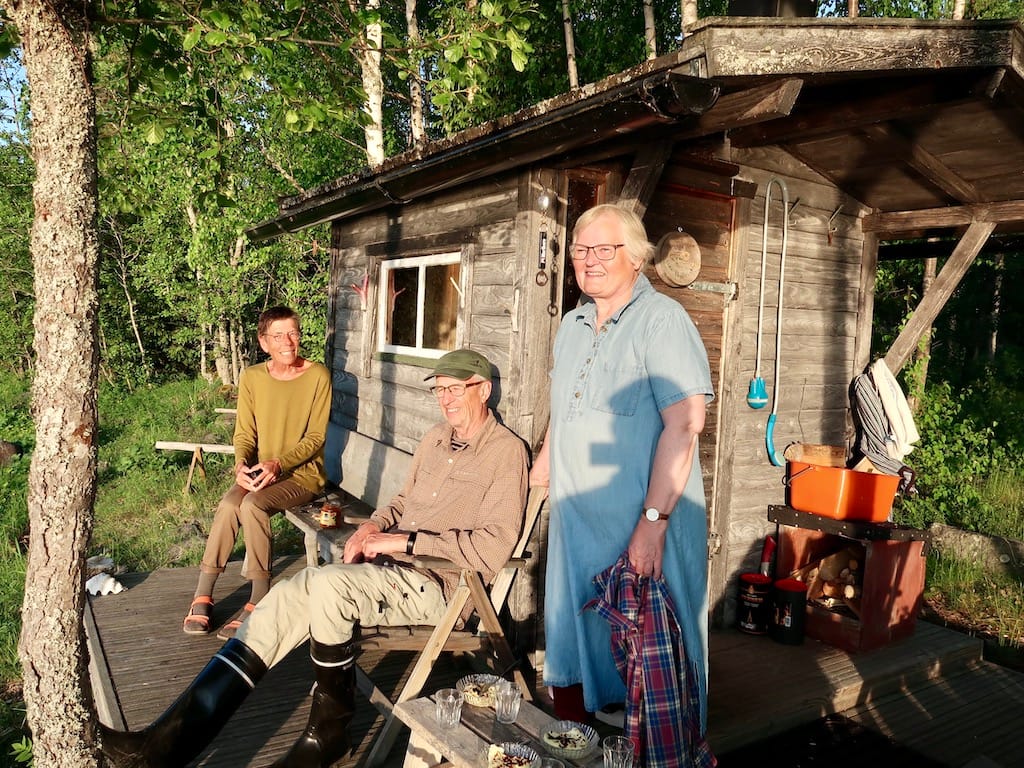
Arktikum and Aalto in Rovaniemi
On our way, north we passed the large wind farm which is being built at Mutkalampi. Near Lapland's capital, Rovaniemi, we saw the first reindeer on the side of the road, unimpressed by the traffic. The town is located where the rivers Kemijoki and Ounasjoki meet. We camped with a view of the iconic Lumberjack's Candle Bridge, which has lights at the top similar to the woodcutters’ burning, split logs.
Rovaniemi was almost completely destroyed when the Germans retreated during World War II. It was rebuilt based on a city plan by Alvar Aalto shaped like a reindeer head with antlers. Aalto also designed the buildings of the cultural and administrative centre. Lordi’s Square has a monument to the heavy rock band that won the 2006 Eurovision Song Contest with the song "Hard Rock Hallelujah".
Arktikum is an impressive science centre and museum focusing on arctic nature, history and culture in a building designed by Danish architects under the direction of Claus Bonderup. Local materials have been used in the partially underground construction, which was inaugurated in 1992. It is connected by a long glass corridor that opens onto a garden with arctic plants. When we visited Lapland, the northern lights were not visible, but we experienced them in a film shown on the ceiling. A Finnish myth says that the heavenly lights are created by a fire fox swinging its tail.
The house next door to Arktikum is a large wooden building, where the Pilke Science Centre tells about sustainable forestry in an interactive exhibition that offers opportunities to cut down virtual trees, go on virtual hunt and much more. The enormous machines in the exhibition made Hanne consider, whether the garden tractor on her family's natural plot should be replaced with more efficient equipment.
In a hardware store, we bought a pair of Fiskars scissors with orange handles as a replacement for those that had served us well for many years. In the shop, Lauri Lars found a fine pocket knife with a curly birch handle shaped by the knife maker Johannes Lauri in the 1920s.
The midsummer festival on 23 June brought together generations in a park and in boats on the river. Children rode hobby horses, young people listened to music, families settled on picnic blankets. The highlight was the bonfire, which was lit by dancing fire jugglers. There was a warning of forest fires in the area, so fire was limited to the river bank. For us, this event marked that we had arrived in the land of the midnight sun.
You can visit Santa Claus in Santa Claus Village at the Arctic Circle north of Rovaniemi. We skipped that, but we discussed with several locals whether he comes from Lapland or Greenland. The closest we came to clarity was a woman in a Christmas store, who thought that the question was whether her mother or our mothers had been mistaken.
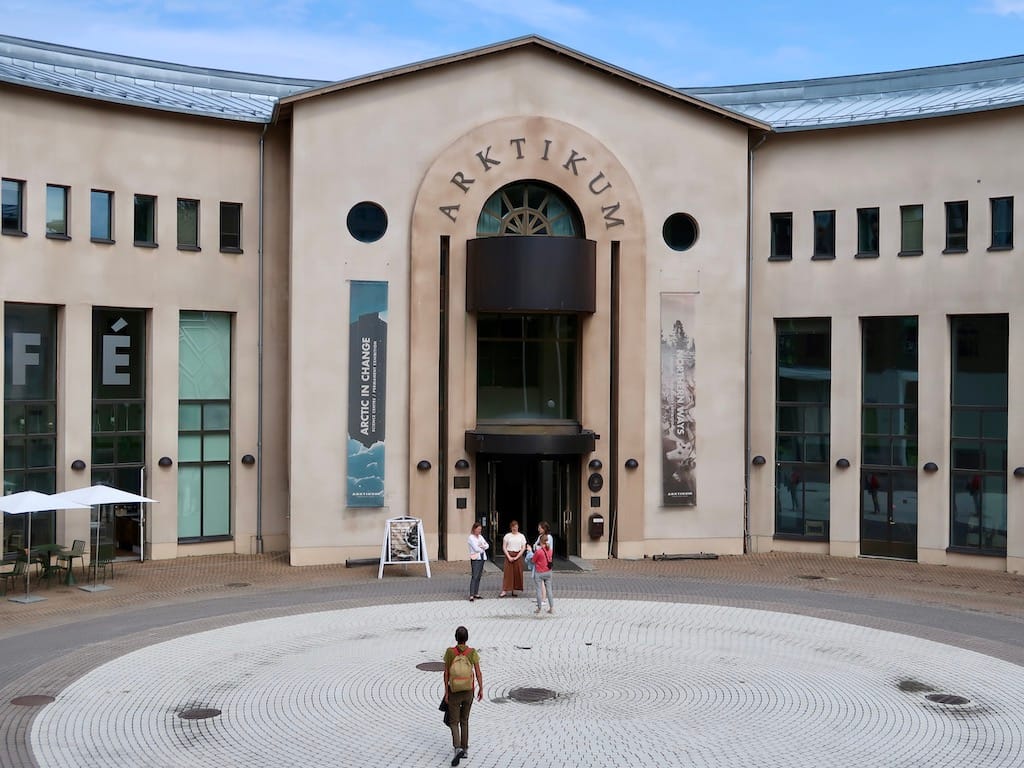
Sami culture in Inari
Inari town is called Enare in Swedish and Aanaar in Inari Sami. Reindeer roam the streets, and the midnight sun makes it difficult to go to bed. An engaged woman showed around Sajos, which houses the Sami Parliament and Cultural Centre. The name means meeting place, the star-shaped wooden building was inaugurated in 2012. Parliament represents the Sami and deals with questions about their language, culture and status as indigenous people. The shop Duodji sells Sami handicrafts of high quality.
Siida is a cultural and natural history museum with a permanent exhibition under the title "These Lands are our children". Large nature photographs of the changing seasons impressed. A special exhibition conveyed a project about repressed and forgotten symbolic values in Sami women's headdresses. The open air museum shows Sami dwellings, storage sheds, animal traps, etc. The exhibition "Zero Arctic" told about the building techniques of indigenous people as inspiration for climate-friendly construction.
A beautiful boat ride on Lake Inari passed the Sami's sacred island of Ukko and islands where they buried their dead. An equally beautiful hike took us on to Pielpajärvi Wilderness Church from 1760, which is located on a traditional Sami gathering place. The church is a charming wooden building that is still used for weddings and for services on special occasions.
The encounter with Sami culture was inspiring. Sami people live in Norway, Sweden, Finland and Russia. In Finland, there are three groups with different languages. The Sami understand each other across language differences, and they cooperate internationally in the Sami Council.
The origin of the Sami is uncertain, there are archaeological finds from around the year zero. They were originally hunters and gatherers, some became nomads and followed the migration of the reindeer. Now they are permanent residents and monitor the animals using GPSs, ATVs and snowmobiles. Their way of life has survived despite harsh climatic conditions and pressure from the majority populations, it continues to be threatened by among other things construction projects and the climate crisis. Many Sami today live outside the northern Sami areas. In the 1970s, a self-confident Sami counterculture emerged. We saw a few Sami people in traditional brightly colored jackets, but did not get a chance of hearing their evocative yoiks.
In Inari Sámi Church, the altarpiece shows the resurrected Jesus in an arctic landscape with a Sami family and a reindeer. Here we met two young men, one continuing the family tradition as a shepherd, the other training to become a welder.
In Sompio Souvenir Shop south of Inari, we bought a shaman drum made of animal skin decorated with Christian and Sami symbols. - In traditional Sami religion, nature and the universe are magical frameworks for human life, which must be met with careful respect.
After making sure that Google Maps couldn't by mistake lead us into Russia, we drove on deserted roads through forests and past lakes near the border. We met reindeer herds, passed the Arctic Circle and a good 500 kilometers to the south, we got an overnight stay with a bonfire in Hossa.
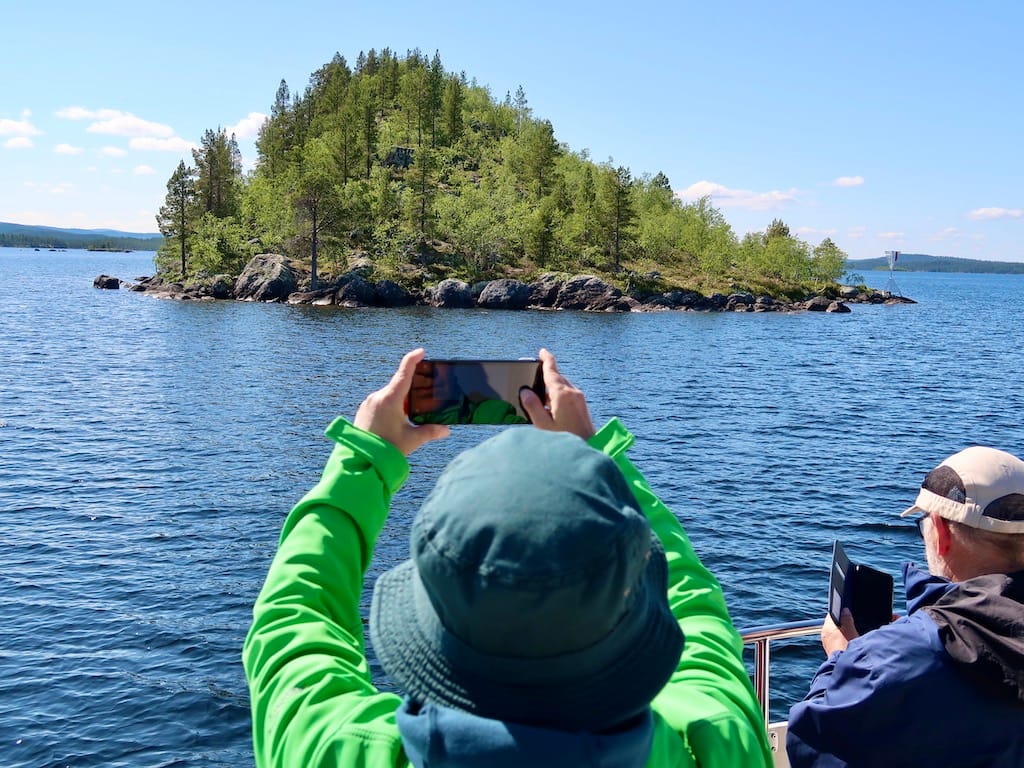
The Winter War Monument
In Suomussalmi we stopped at the Winter War Monument, 1939 – 40. Many thousand boulders commemorate the fallen on both sides. 105 bells ringing in the wind symbolizes the absurdity of the war and the number of days it lasted. The nearby Winter War Museum is owned by a man whose father was a soldier. A documentary tells about the violent battles.
The Soviet Union invaded Finland without a declaration of war, with poorly equipped Ukrainian soldiers and a plan to take Helsinki in two weeks. The Finns resisted in familiar terrain, but lost most of Karelia. The defeat became the starting point for the Continuation War 1941 – 44. – We were reminded of Russia's invasion of Ukraine.
There were many visitors of all ages at the monument and the museum. A young couple from Helsinki told that they came to refresh their school knowledge about the war, and said: "It's good that Finland joined NATO, we changed our attitude towards membership in one year."
At Koli Camping, we met Nina, who told us about her grandfathers' participation in the horrors of the Winter War and the Continuation War. "The wars are very present for all Finns", she said.
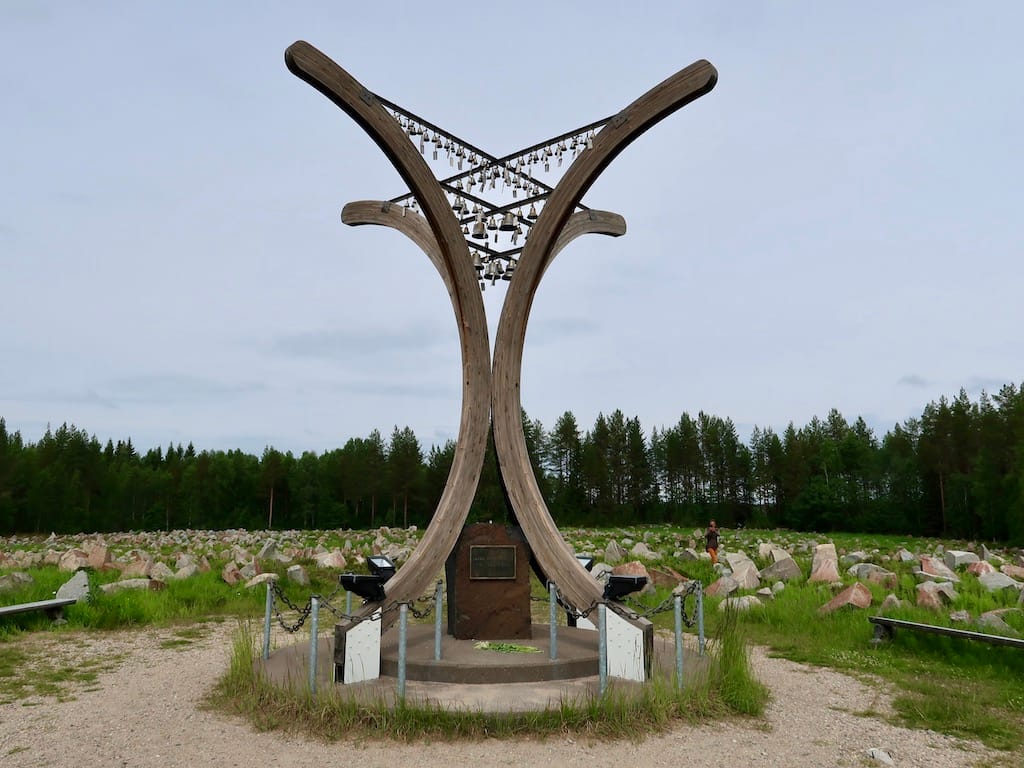
Artists in Koli National Park
Koli Nature Centre introduces the natural and cultural history of the national park: the ice age shaping the landscape, the stone age settlements, the 17th century fear of evil spirits, the 18th century sweat farming and the 19th century artists' descriptions in the national romantic project that showed the way for tourists.
The folklorist Elias Lønnrot collected folk poetry in Karelia for the national epic Kalevala, which was published in the first edition 1835. The painter Eero Järnefelt depicted people and nature in the decades around the turn of the last century. The composer Jean Sibelius visited and was inspired by Karelia and Koli on his honeymoon in 1892.
We hiked the route to the peaks of Ukko-Koli, the old man, Akka-Koli, the old woman, and Paha-Koli, the evil one. The reward was terrific views over Lake Pielinen. Families in trekking clothes helped us with local guidance.
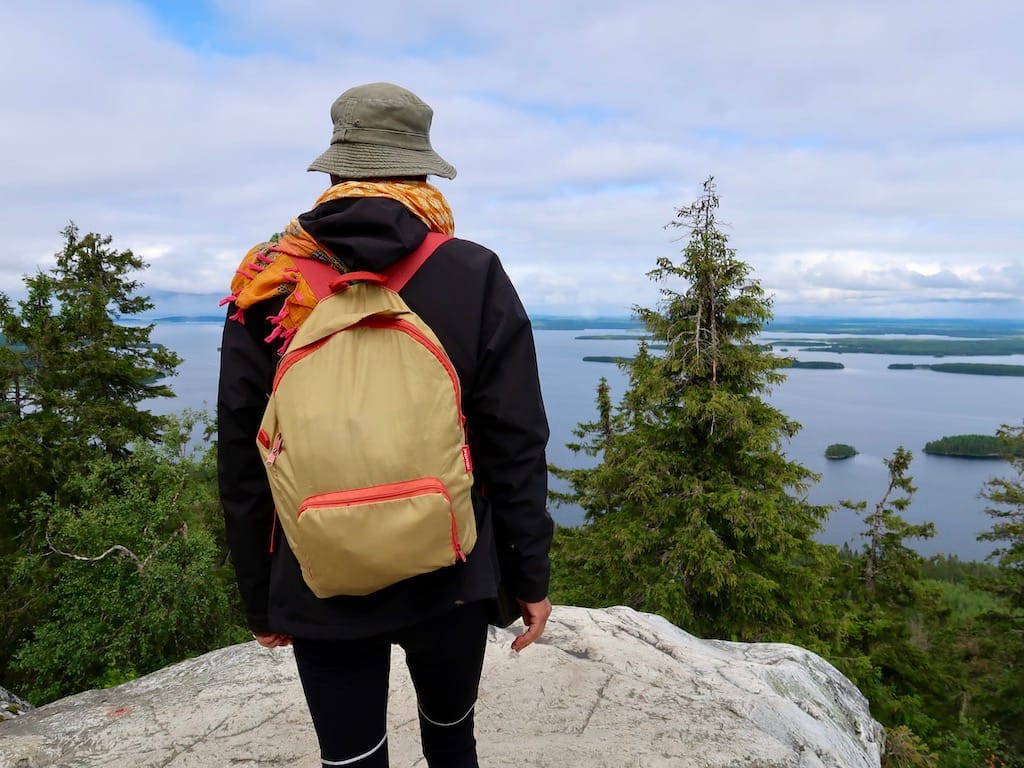
The border with Russia at Imatra
The border town of Imatra is located by the Vuoksi river's Imatrankoski rapids. They are mentioned in the Kalevala, from the end of the 18th century they became a favourite destination for tourists, and in 1929 they were tamed by the Fortum hydroelectric plant. Normally the falls are only briefly reopened, but during our visit they were flowing around the clock due to repair work at the power plant. Chutes past the dam make it possible to float timber on the river.
Hotel Imatran Valtionhotelli is a castle-like building in Art Nouveau style, which in 1903 replaced burned down hotels. The Veteran Museum tells about the wars that shaped modern Finland. The collection was created by the current owner's parents and is housed in their stately villa.
We cycled to Alvar Aalto's fine, white Church of the Three Crosses from 1958, it is furnished with sliding walls so that the room can also be used for meetings. The church was partially closed due to problems with the indoor climate. We also saw the small Orthodox wooden church of St. Nicholas from outside. By the river, we spoke to two women who were washing rugs in a space with tables, rollers and drying racks. We met them in several places in Finland, the women had wondered whether they are also found in other countries. We told them that the phenomenon is unknown in Denmark.
Before the corona crisis and the war in Ukraine, there was lively trade and tourism between Imatra and Russia. By now, border traffic had largely come to a standstill, and several shops and cafes were closed. We took a few kilometres along Via Karelia, which we had followed for long stretches from Lapland, but here the road was completely deserted. Our goal was to see the border fence that was being built. We gave that up not to get in trouble with the border zone, which requires a special permit to enter. A woman at the campsite thought it was a "kindergarten fence" - too low and too short to have an effect.
In November 2023, the Finnish government first closed the border crossing at Imatra and three other locations in south-eastern Finland. There were reasonable suspicions that Russian authorities provided undocumented asylum seekers from third countries with a bicycle and let them pass in a form of hybrid warfare. President of the European Commission Ursula von der Leyen supported the decision. Later, the four northern crossings were also closed.
Additional border fences were erected and Finland received help from the European Border and Coast Guard Agency Frontex, with a declared focus on both border security and humanitarian considerations. The border closures were to be temporary, goods could pass and asylum seekers could still come to Finland via ports and airports.
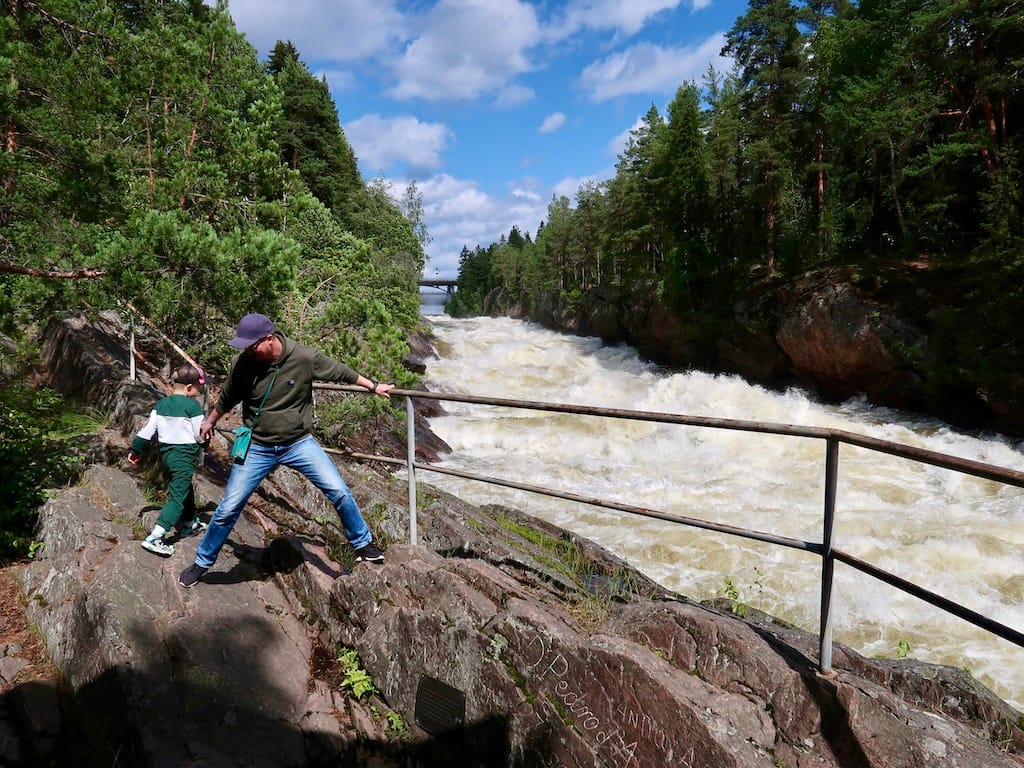
Punkaharju and Olavinlinna
We drove over Finland's largest lake, Lake Saimaa, along the picturesque Punkaharju ridge. On a rainy day in Punkaharju Resort, we enjoyed the view over the lake towards a forest edge with tall trees and many shades of green. We likewise enjoyed talking to camping neighbours as well as following families' boat and swimming trips between showers.
Our next stop was the medieval castle of Olavinlinna, which is located on an island where the current prevents the lake from freezing. We were given a guided tour through large halls and narrow staircases. Construction was begun in 1475 by the Danish knight Erik Axelsson Tott. The castle has been in Swedish, Russian and Finnish hands. The restoration as a historical monument and tourist destination began in the 1870s. When we visited the castle, a large tent stood in the courtyard as a setting for the Savonlinna Opera Festival,
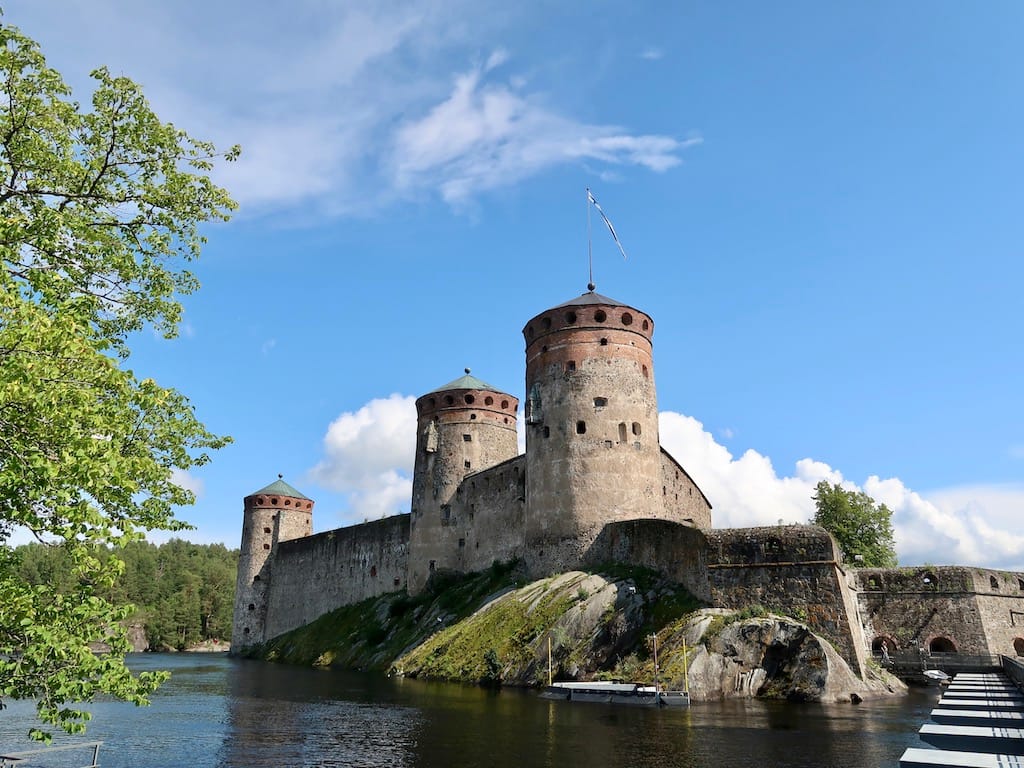
The Orthodox Church in Kuopio
We visited Kuopio to see the headquarters of the Orthodox Church. Was expecting something big, but found the fine little St. Nicholas Cathedral with onion domes, beautiful icons and friendly people who were busy saving a bird that had flown through the open door.
We also visited the Orthodox Church Museum RIISA, which exhibits religious objects from the 16th century to the present day collected from churches and monasteries. It had special exhibits on Easter eggs as a symbol of resurrection and on Soviet anti-religious propaganda.
Kuopion Museo is a fine cultural and natural history museum. You meet a hairy mammoth, and find the relationship between humans and nature illuminated in the realm between myths and reality. A breathtaking film ties cultural and natural history together in a description of the seasons. The special exhibition was the international "Wildlife Photographer of the Year".
The heart of the city is the square with the town hall, stalls with food, handicrafts and sometimes thin, birch branches with leaves for the sauna. The Puijo Tower stands high on a hill outside the city with ski jumps and ski lifts, used by daring boys to get steep rides down on mountain bikes. The tower offers a great view of Kuopio and the surrounding lakes and forests.
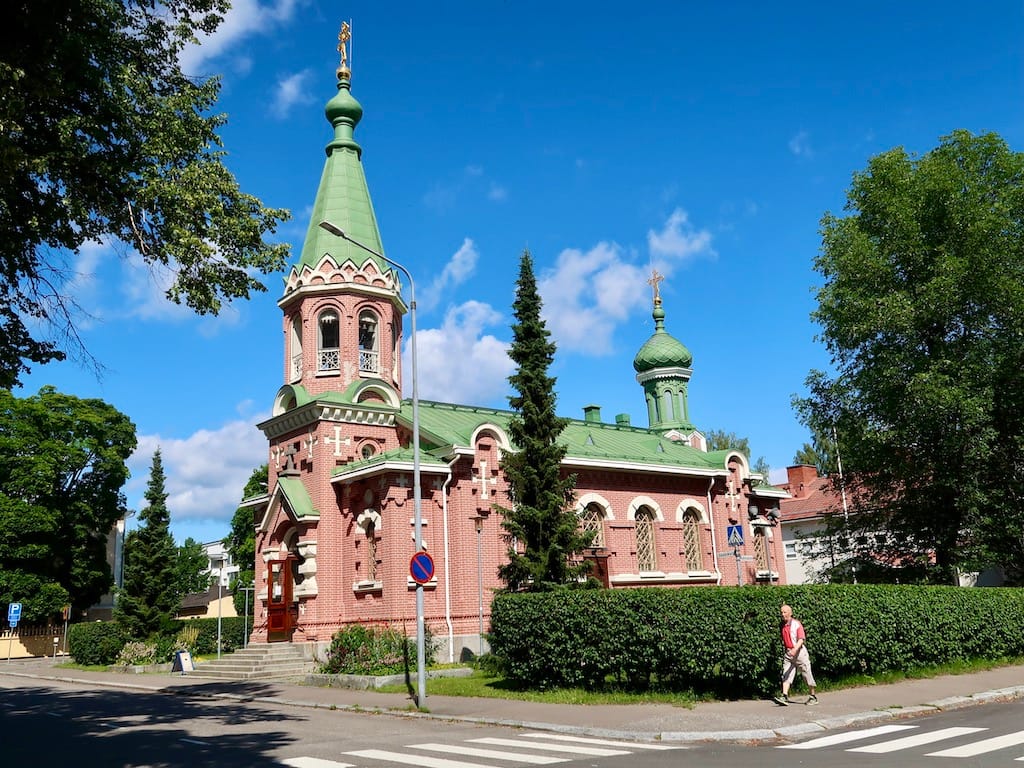
Alvar Aalto around Jyväskylä
We had seen many majestically stuffed elks in Finnish museums. On the way to Jyväskylä, a live elk came out of the forest, stood for a while and watched the traffic before deciding to walk back.
We visited Jyväskylä to deepen our understanding of Alvar Aalto's architecture. He lived in the city as a child and returned after his education. When his career became national and international, he moved first to Turku then to Helsinki.
The Alvar Aalto 2 Museum Centre was designed by the master himself. It has permanent exhibitions about his work and life as well as about the history of Jyväskylä. Special exhibitions focused on UNSECO World Heritage and on Finnish sauna traditions. In the cultural history section, we found our first Nokia phones from around the turn of the millennium.
We saw some of Aalto's buildings in and around Jyväskylä. They gave an idea of his development from classicism towards a modernism with respect for people, traditions, places and natural values. Not least the University of Jyväskylä, Muurame Church, Säynätsalo Town Hall and the family’s Italian-inspired summer residence on the island of Muuratsalo were impressive.
Aalto ironically named the speedboat he designed to get to and from the summer house "Nemo propheta in patria", "no one is a prophet in his fatherland". - Now Finland is working to get some of his works included in UNESCO's list of World Cultural Heritage.
The last three sights we visited in Finland are on the list.
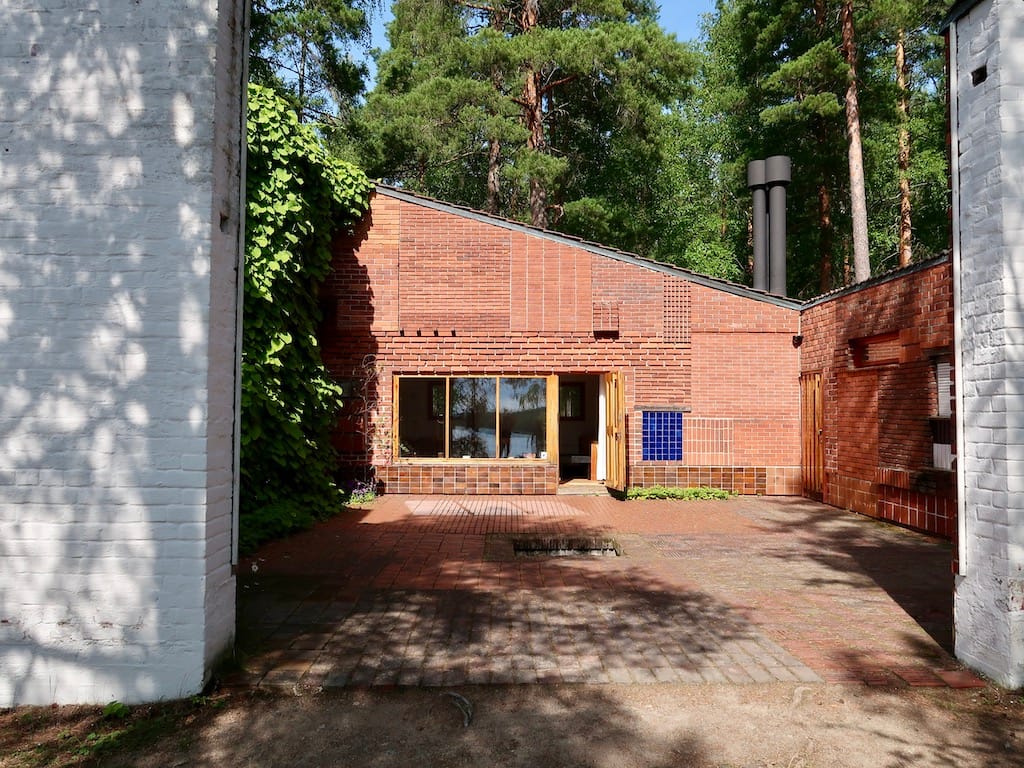
Petäjävesi Old Church and motor race
The tar scented wooden church in Petäjävesi was built by local builders in the 1700s and 1800s. We had a knowledgeable introduction to the church by two young women. They showed us the big door key and told us about services where the congregation sat divided according to gender and social status. We saw the craftsmen's initials in the woodwork and a finely carved Saint Christopher standing under the pulpit. The church is cultural heritage but also a living religious institution, there had just been a wedding.
On the road by the church, fast racing cars passed. We had noticed that there are many large American cars, heavy SUVs and powerful ATVs in Finland. This is probably due to the terrain and the climate, but perhaps also, as one of the race participants said: "Finns have petrol in their blood."
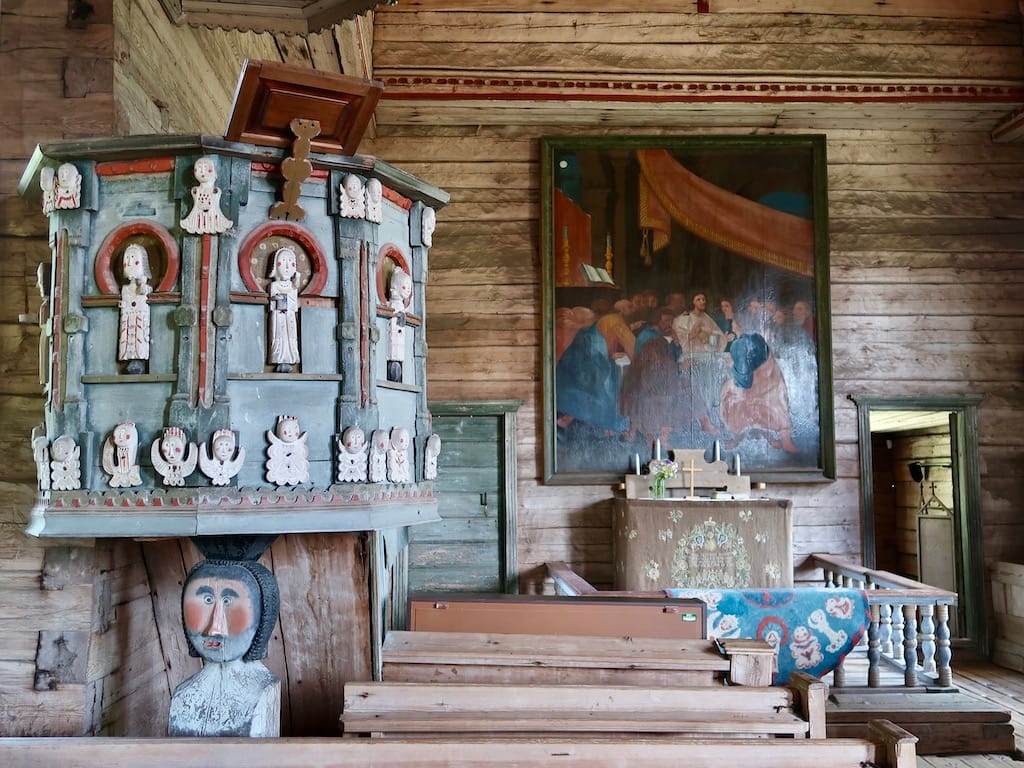
Struve Geodetic Arc with a view
At the beginning of the 19th century, the German-Russian astronomer Friedrich Wilhelm Struve wanted to determine the shape and size of the earth through triangulation based on measurement points in ten present day countries from Norway in the north to Ukraine in the south. Six of the points are in Finland, we visited one west of Jyväskylä. It is reached by a footpath and marked by a stone and a tower overlooking the landscape.
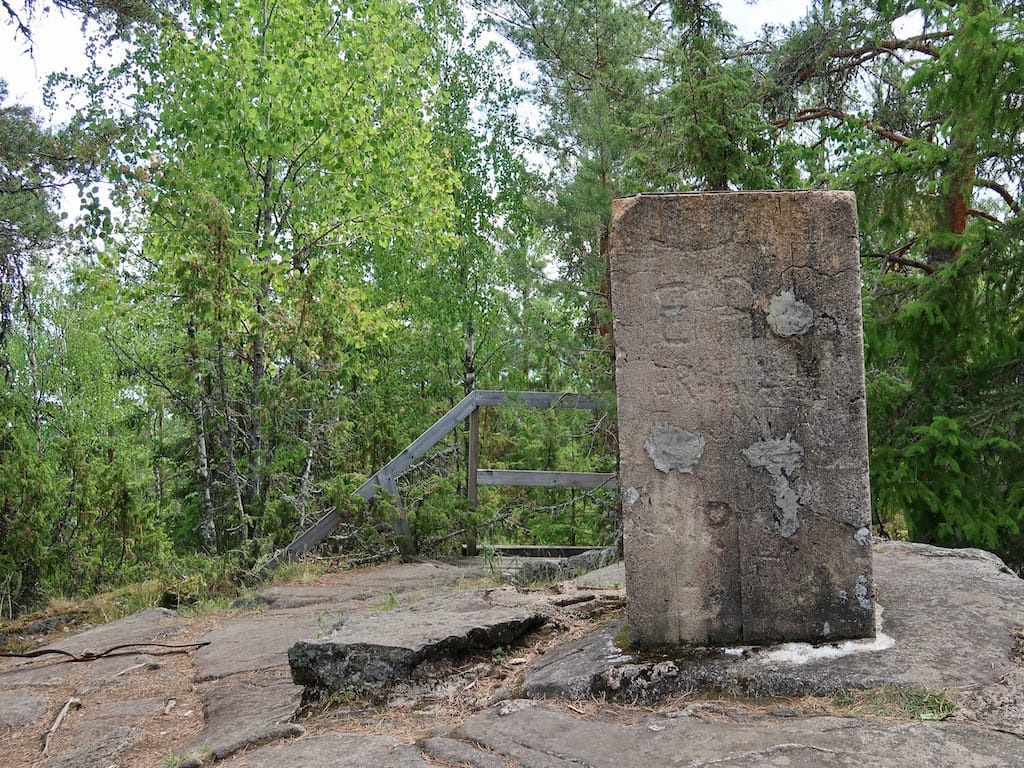
Early industry in Verla Groundwood and Board Mill
Verla Groundwood and Board Mill stands by the Verlankoski Waterfalls. Production began in 1872, the church like red stone building dates from the turn of the century. We were given a tour, that told about the logs journey from floating on the river, through debarking, cutting, grinding into pulp, shaping into cardboard, drying and weighing. The factory is located in a garden with a stylish manager’s residence, clerks and workers lived in the village by the factory, some of the wooden houses are rented out as holiday homes.
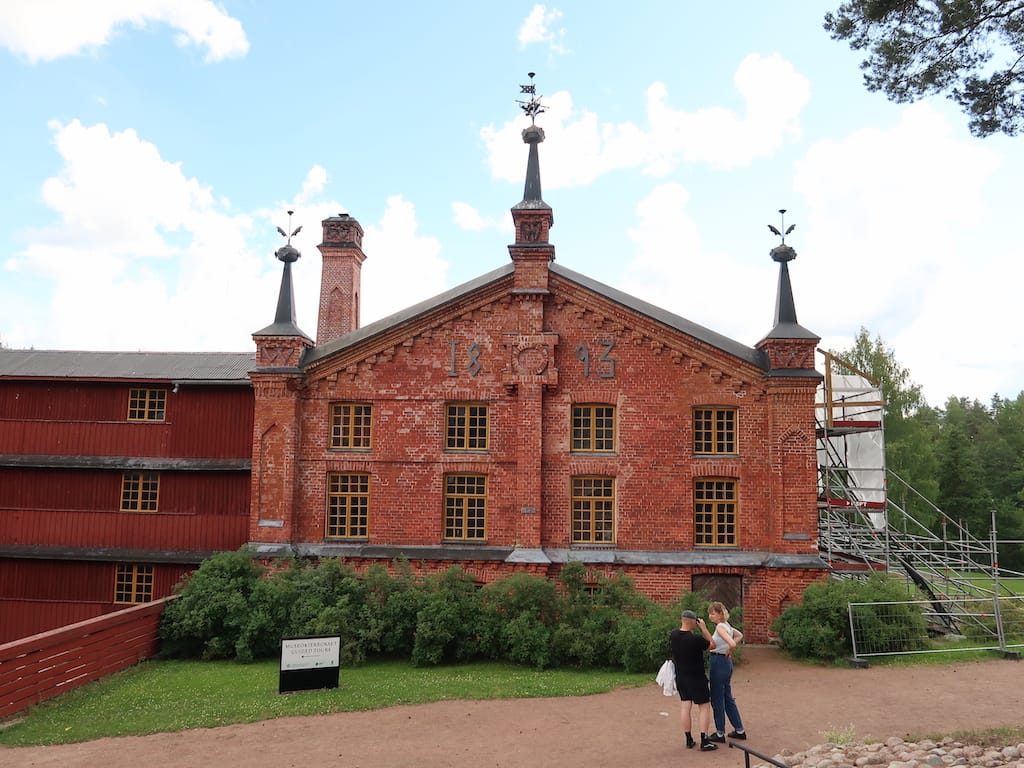
The ferry and home
We had some quiet days at a campsite east of Helsinki, before we found the ferry to Stockholm and the road to Odense. After two months of Finnish nature bathing, we experienced the ferry as more crowded and noisier than on the outbound trip, but the cabin's panoramic view was still good.
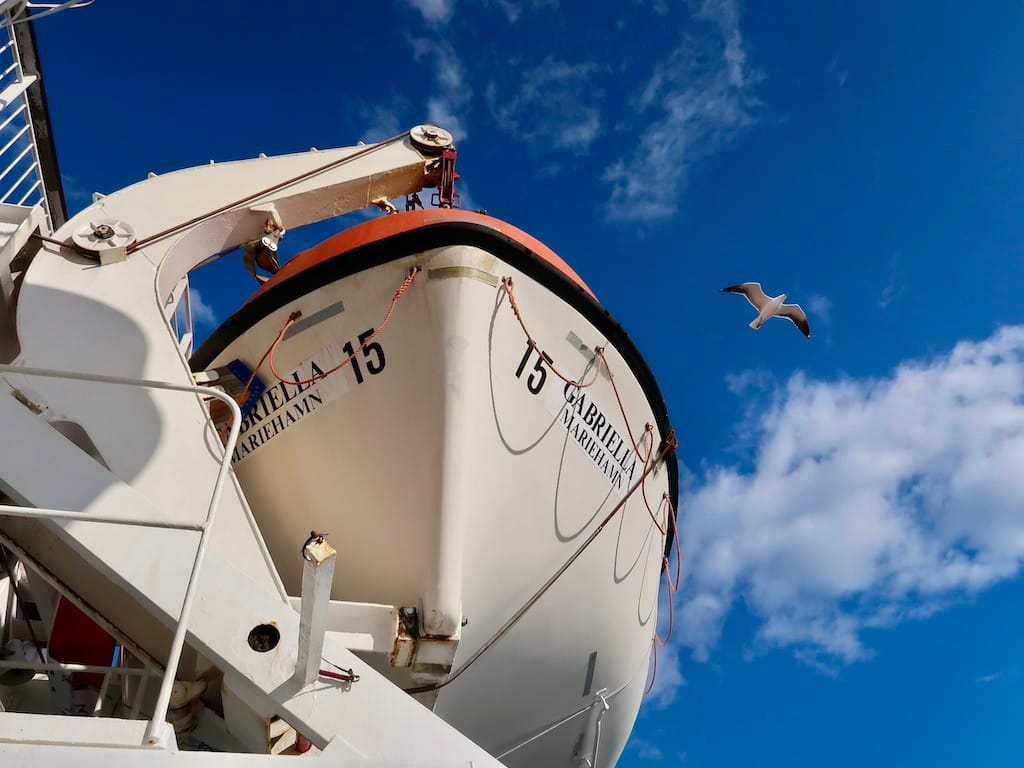
December 2023.
